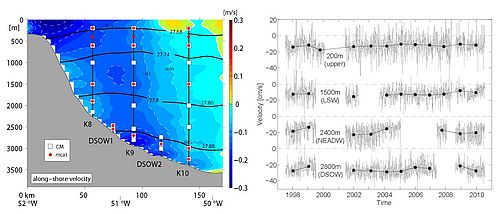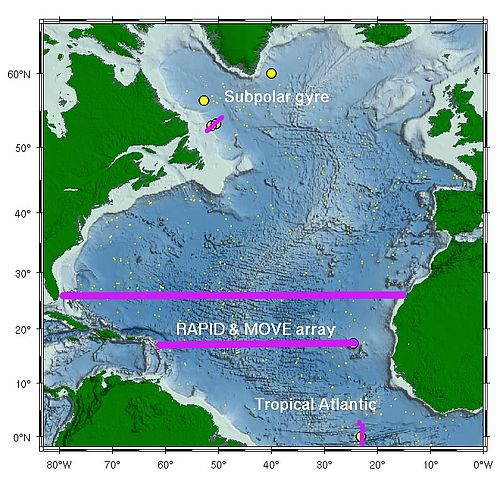Decadal Climate Predictions (MiKlip, Module 3)
Verification of Ensembles and Initialization Fields for Decadal Climate Predictions via Ocean Observation Systems (OCEANOBS)
Time series observations have been an important tool in oceanographic research for many years. They permit direct statements regarding the variability in key regions, and they can be used directly to constrain the initialization of oceanic forecast models, and to verify the decadal prediction system in ‘hindcast’ mode. This has been clearly demonstrated in the TAO/TRITON system using more than 40 long-term moorings which significantly contributed to the predictability of the El Nino phenomenon as well as an understanding of decadal variability in the Pacific. The North Atlantic currently also features a number of long-term observational systems (Fig. 1) which - to a large degree - have been operated and analyzed by our own group of scientists in conjunction with several international partners and the global Argo profiling float system. These systems are extremely well suited for the verification and analysis of decadal prediction models. Individual components are currently being used for this exact purpose. However, the available data have not yet been used in their entire width and depth for the systematic verification of ensemble ocean predictions. We therefore propose to implement a concerted analysis of these time series observations aimed at assessing the quality of ensemble predictions in the ocean. This work will be in close collaboration with MiKlip Modules A and D to facilitate an optimized and homogenized comparison between models and observations. The methodology calls for the development of a series of space and time integrating ocean climate indices for various regions and aspects of the ocean, and to compare those with models. The indices will cover a range of ocean aspects such as ocean deep water transports, ocean heat content changes in various layers and regions, zonally integrated meridional ocean transports and changes in regional ocean salinity. The information will also be used in the context of the investigation of mechanisms of decadal variability (Module B, objective B3). In terms of regional focus, the analyses will concentrate on three climate-relevant regions of the North Atlantic:
R1) the convection regions of the sub-polar North Atlantic (Labrador Sea, Irminger Sea) in order
- to document the long-term changes in the formation and spreading of water masses, and
- to quantify the export of these water masses from the Labrador Sea into the interior of the ocean;
R2) the basin-integrating meridional transports along 16°N (MOVE) and 26°N (RAPID)
- to assess the effect of various transport components on the Meridional Overturning Circulation (MOC), and
- to investigate the effect of MOC variations on the temporal evolution of large-scale sea surface temperature changes;
R3) the zonal transports in the near-surface equatorial Atlantic to investigate
- the supply of thermocline water toward the upwelling zone of the equatorial Atlantic, and
- the link between the dominant modes of the Tropical Atlantic Variability (meridional SST gradients and Atlantic El Nino) and zonal current variability.

Principal Investigators
All at:
GEOMAR | Helmholtz Centre for Ocean Research Kiel, Düsternbrooker Weg 20, 24105 Kiel, Germany
Fax: +49 431-600-4102
| Name | Phone |
| Prof. Dr. Martin Visbeck | +49 431 600-4100 |
| Prof. Dr. Peter Brandt | +49 431 600-4105 |
| Dr. Jürgen Fischer | +49 431 600-4106 |
| Dr. Johannes Karstensen | +49 431 600-4156 |



